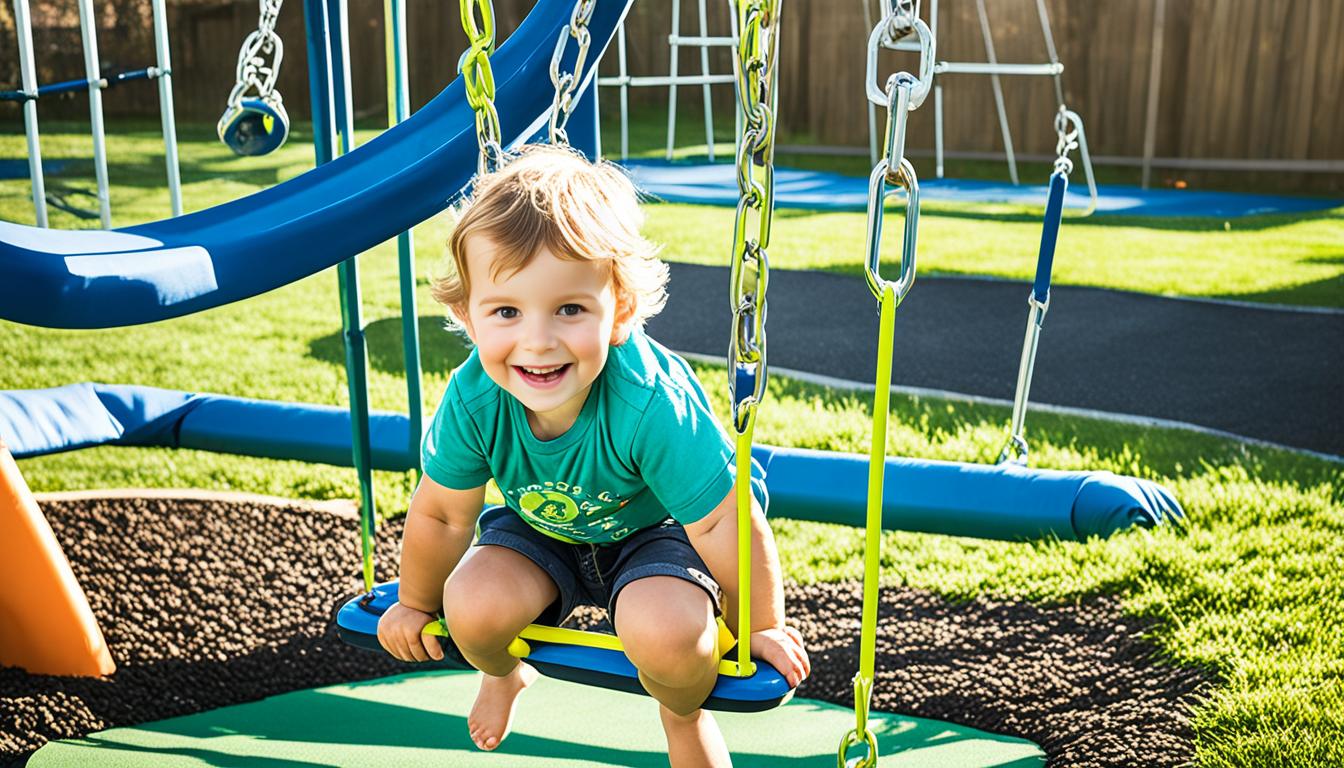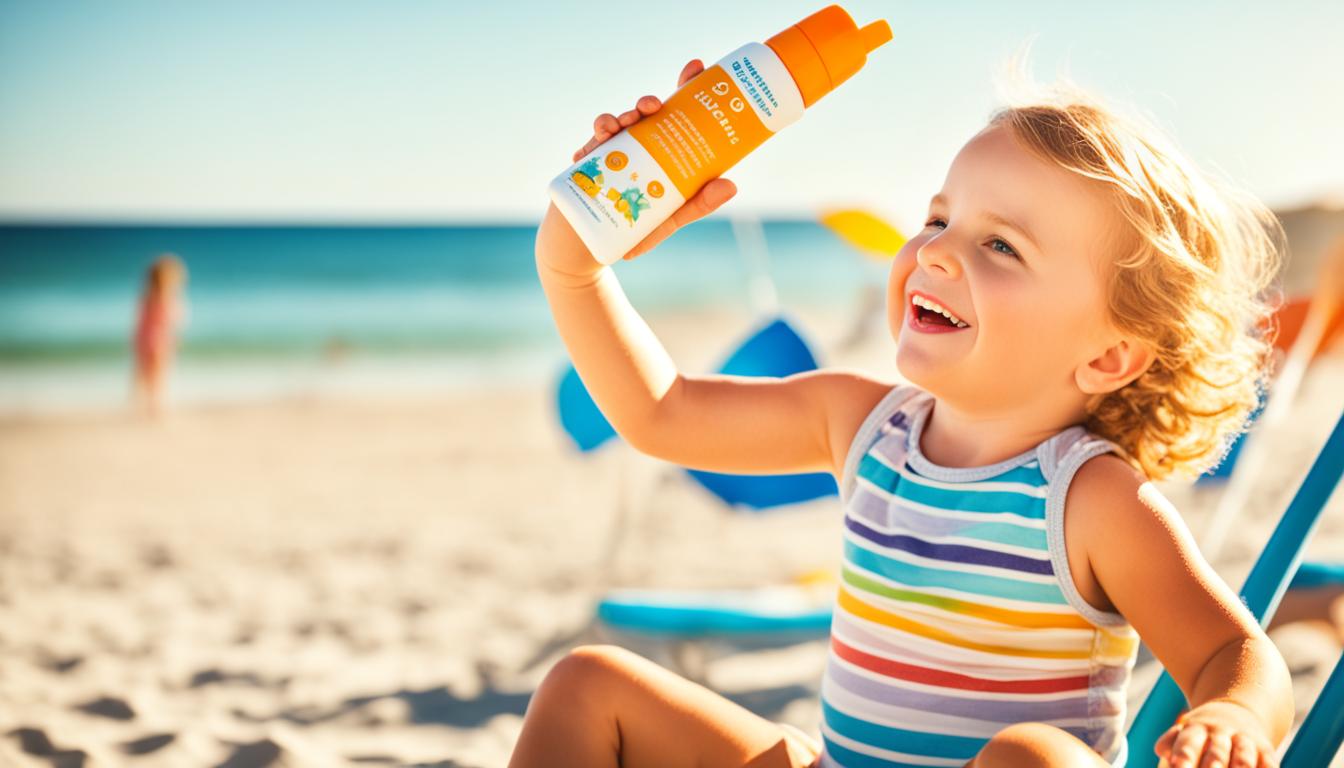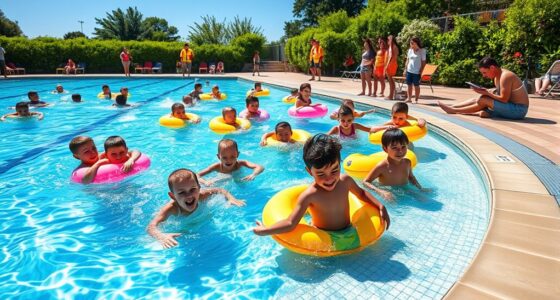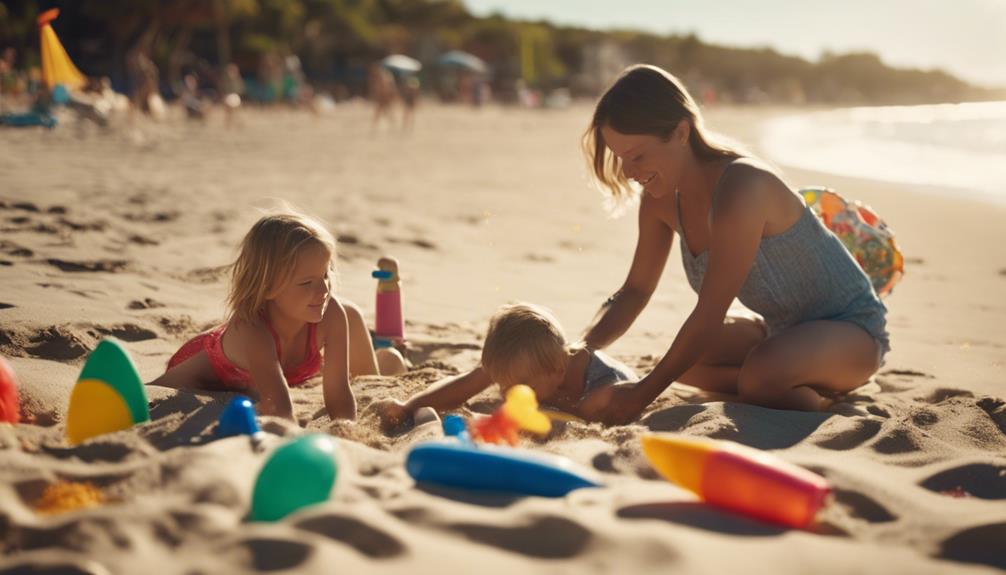Did you know drowning is the top cause of death for kids under four1? It shows how vital Outdoor Play Safety is. It keeps your child safe while they enjoy fresh air and exploring outside. Outdoor activities boost Kids’ Health, but safety must come first. Your careful watch helps make Safe Play Areas. These areas stop accidents and help kids grow in a safe way. We’ll share key tips for ensuring your kids’ outdoor play is both fun and safe. With these guidelines, your children can explore confidently and safely.
Key Takeaways
- Outdoor play significantly benefits children’s physical, cognitive, and social development.
- Active supervision is critical for ensuring the safety of kids during outdoor activities.
- Maintaining a safe play environment includes inspecting equipment and surrounding areas.
- Weather precautions, such as appropriate clothing and sun protection, are essential for outdoor safety.
- Drowning is a major risk, emphasizing the need for vigilant supervision near water sources.
- Choosing age-appropriate play equipment minimizes risks associated with injuries.
- Regular maintenance of outdoor play areas helps prevent injuries and accidents.
Importance of Outdoor Play for Child Development
Outdoor play is vital for your child’s health and growth. It provides fresh air and sunshine, helping in overall child development. Kids who play outside gain more benefits than those who stay indoors. The American Academy of Pediatrics recommends outdoor play as a way to fight obesity in children2.
Benefits of Fresh Air and Sunshine
Being outdoors gives your child fresh air and sunshine, crucial for wellness. Outdoor activities help produce vitamin D, important for the immune system and bones3. It also lessens the chance of being overweight. Kids should play outside for at least an hour daily3. Plus, spending time outdoors often leads to better sleep for 2 to 5 years old2.
Physical, Cognitive, and Social Skill Development
Outdoor play boosts physical and cognitive skills. It improves motor skills and thinking as children explore and solve problems. Older kids focus better and do well in school when they have recess time. This supports better learning2. Playing outside also boosts children’s confidence and social skills. They learn to communicate and make friends while playing3.
Understanding the Risks of Outdoor Play
Playing outside is great for kids but comes with its dangers. It’s important to recognize these Outdoor Play Hazards for better Safety Management. Kids might deal with uneven grounds, rough play, or sudden weather changes. These problems can cause anything from minor cuts to serious injuries. The CDC’s report from 2000 to 2006 shows how common these outdoor injuries are among kids aged 0-19 in the U.S4..
Common Hazards in Outdoor Environments
When kids play outside, they face certain risks. For example:
- Tripping over uneven ground.
- Lack of supervision leading to dangerous activities.
- Unexpected changes in the weather.
Kids today might not be playing outside as much. This can impact their physical health and happiness4. In cities, children might not know the local play areas well. This makes them hesitant to explore5. Parents need to know about these Parent Concerns for outdoor play safety.
Managing Parent Concerns about Safety
Parents worry about their kids playing outside, and that’s understandable. However, being too cautious can stop kids from growing in important ways. Research shows that playing with some risk helps kids learn to assess danger, make decisions, and solve problems5. It’s key to realize that a little risk is part of growing up. By teaching parents proper Safety Management, kids can safely explore and learn from their experiences.

Outdoor Play Safety Recommendations
Making sure kids are safe and have fun outside is crucial. By following the S.A.F.E. Tips, caregivers can avoid dangers and create a positive play area.
Adhering to the S.A.F.E. Guidelines
The S.A.F.E. Tips involve Supervision, adjusting activities to be Age-Friendly, using safe Fall surfaces, and keeping Equipment in check. Watching kids closely outdoors is key to stopping accidents. It’s advised to keep an eye on them at all times6. Teach them to avoid streets and come inside if the weather turns bad, like during thunderstorms6. Also, wearing helmets while biking or skateboarding can protect their heads6.
Maintaining Proper Supervision
Good supervision means actively participating, not just watching. Understanding the child’s growth stage helps cater to their needs. Making sure they take breaks and drink water prevents overheating and dehydration6. Encouraging the use of sunscreen SPF 15 or more and regular application guards against sunburns7. Wearing long sleeves and using EPA-approved bug sprays can keep children safe from insects and toxins outdoors7. Ensuring kids play safely together can also lessen playtime risks.

Creating a Safe Outdoor Play Environment
Creating a safe outdoor space for kids means choosing the right play equipment and safety surfacing. This makes a place where kids can play and have fun safely. By focusing on these areas, we lower the chance of getting hurt and make playtime better for everyone.
Choosing Appropriate Equipment for Different Ages
It’s important to pick play equipment that matches kids’ growing abilities. The National Program for Playground Safety lists four key things for a safe playground: keeping watch, picking stuff that is right for each age, having safe surfaces for falls, and keeping equipment in good shape8. Different needs and skills of very young kids, those starting to walk, and older toddlers matter a lot when setting up outdoor play areas9. Picking gear that fits each age group and designing thoughtful spaces helps children grow safely and have fun outside.
Ensuring Safe Surfacing Under Play Structures
The ground under play structures is very important to reduce injury risk from falls. Good fall zone surfaces can lower how often and how badly kids get hurt when they fall8. Choices like wood fiber, rubber mats, and mulch can soften impacts. Regular checks keep everything in top shape, keeping play areas safe. A remarkable 92% of play areas follow the latest safety rules from the Public Playground Safety Handbook9. This shows a big effort to keep outdoor play areas safe for kids.

Active Supervision: Your Role as a Caregiver
Active supervision is key to keeping kids safe while they play outside. As a caregiver, it’s your job to watch over them and prevent accidents by using smart strategies. Knowing what each child needs for their development helps you make play safe and fun.
Techniques for Effective Supervision
Caregivers need to use a few important methods for good supervision. It’s essential to watch, count, and listen to the kids, especially when things are changing. Being able to see all the children quickly lets you spot dangers early. This matches the safety rules of the Head Start programs10. Counting the kids regularly, like every 15 minutes, makes sure everyone is where they should be and keeps adult-child ratios right11.
- Make sure you can see all the play areas well by standing in the right spots.
- Use walkie-talkies to talk to other grown-ups. This way, you can get help without leaving the kids alone.
- Join in with the children to guide their focus and keep them engaged in safe activities.
Understanding Each Child’s Developmental Needs
Knowing what makes each child unique makes you a better caregiver. If you can guess how they might behave based on their development, you can stop accidents before they happen10. Outdoors, you need to change how you watch over them to match their need for independence and understanding of safety. For example, leaving older kids alone briefly during bathroom breaks is okay, but always be close enough to hear them11.
Having a good plan for supervision means kids stay safe and have fun learning. This creates a happy, secure place for them to play.

Outdoor Play Safety: Addressing Weather Concerns
Weather plays a big role in outdoor safety for kids. Caregivers need to watch things like Air Quality and how hot or cold it is. Making sure kids are safe from the weather is really important, mainly when the weather is very harsh.
Monitoring Air Quality and Temperature
Knowing about air quality is important, especially for kids who have breathing problems like asthma. It’s good to know about air pollution levels and ozone issues before kids play outside. In hot weather, if it gets hotter than 90 degrees, kids face health risks12. If the temperature reaches 105 degrees or more, it’s better to stop any outdoor activities13.
In the cold, there are dangers too. Teachers should look at how cold it feels outside when the wind is blowing and it’s around 30 degrees. There’s this system that uses colors to show when it’s okay for kids to play outside safely. It’s best when the temperature is between 40 and 32 degrees and the wind is not too strong14.
Proper Clothing for Varying Weather Conditions
Choosing the right clothes for outside play keeps kids safe from weather problems. For cold weather, wearing several warm layers, hats, and insulated boots is key. This helps to avoid getting too cold or frostbitten14. In hot weather, outfits that protect kids from the sun are important, especially between 10 a.m. and 2 p.m., when the sun is strongest12.
There are special guidelines for extreme weather to keep kids safe. For example, when it’s really cold, from 10 to 19 degrees, outdoor play should be no more than 45 minutes13. Getting kids ready for different weather conditions not only makes their playtime fun but also keeps them safe.

Protective Measures Around Pools and Water
Water accidents are a big worry for little kids. It’s crucial to put up barriers and follow safety steps to keep pools and water places safe. Every year, almost 900 young ones die in water accidents, with most drownings at home15. By acting early, we can cut down dangers and protect kids around water.
Importance of Barriers and Safety Protocols
Putting up a fence that goes all around the pool cuts drowning risks by 83%16. This kind of fencing stops kids from getting near the pool without an adult, which is key. Most drownings happen when kids aren’t even swimming15.
It’s also important to check that pool covers, fences, and gates work right at the start of pool season17.
Constant Supervision Requirements
Keeping a close watch on kids near water is super important. Sadly, 67% of kids who drowned were last seen less than five minutes before17. That’s why adults must take turns watching the kids swimming, to make sure someone is always on the lookout15.
Wearing a life jacket is another big safety tip. The experts say kids and those who can’t swim should wear one approved by the U.S. Coast Guard15.

Home Playground Equipment Safety Guidelines
It’s important to keep home playground equipment safe. This helps prevent injuries and encourages fun outside play. Around 50,000 kids go to the ER each year because of playground accidents, most from falls18. Following certain safety rules can make your playground safer.
Setting Up and Maintaining Equipment
Make sure all playground parts are firmly fixed to the ground. Check them often for any dangers. The ASTM F1148-09 safety standard says don’t hang swings or bars from monkey bars to prevent falls18. Look for equipment that meets safety standards through the IPEMA certification19. Regular checks and making sure the ground is soft can keep kids safe.
Choosing Safe Alternatives to High-Risk Equipment
Stay away from risky playground gear like trampolines. They can cause serious harm. Instead, choose safer options that are still lots of fun. For example, go with soft play areas. These reduce falling and injury risks. Always pick age-appropriate gear and check that the playing surface is safe19.

Safety Practices for Common Outdoor Activities
Going outside is fun, but safety is key, especially near things like grills and fire pits. Keep kids away from these hot spots to avoid burns. It’s crucial they understand why it’s dangerous to touch hot surfaces.
Preventing Burns Near Grills and Fire Pits
Keeping kids safe near grills and fire pits means closely watching them. Teach them to stay three feet away to lower burn risks. Make sure grilling areas have clear markers and barriers to keep them safe. Always let fire pits cool before walking away to avoid accidents.
Ensuring Safe Insect Protection Strategies
Protecting kids from bugs is important when they play outside. Use bug spray during activities to shield them from ticks and diseases. Choose safe repellents, dress them in long sleeves and pants to cover skin. Regularly check for ticks and teach them to avoid eating unknown plants or berries202122.

Conclusion
It’s very important to make sure your child is safe while playing outside. This involves watching them closely, using good equipment, and looking out for dangers in their surroundings. Every year, over 200,000 kids have to go to the ER because of accidents at the playground. Swings often cause these problems23. By sticking to safety rules and choosing the right materials for swings and slides, you can keep dangers low. This lets your child have fun outside without getting hurt.
But outdoor play isn’t just about safety. It’s also key for your child’s growth. Outdoor activities help kids get fit, feel mentally better, and can even protect their eyesight24. By promoting games and creative outdoor time, you help your child grow up healthy and happy. This way, they get the best out of playing outside while staying safe.
In short, keeping your child safe while they play and help them grow is a delicate balance. As someone looking after them, it’s your job to know about safe equipment and how to watch over them. Safe outdoor play makes kids joyful and strong24. It also teaches them to be bold and curious about the world they live in.









